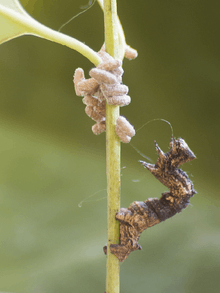Glyptapanteles
| Glyptapanteles | |
|---|---|
 | |
| A caterpillar of the geometrid moth Thyrinteina leucocerae with pupae of the braconid parasitoid wasp Glyptapanteles sp. | |
| Scientific classification | |
| Kingdom: | Animalia |
| Phylum: | Arthropoda |
| Class: | Insecta |
| Order: | Hymenoptera |
| Family: | Braconidae |
| Subfamily: | Microgastrinae |
| Genus: | Glyptapanteles Ashmead, 1904 |
| Species | |
|
G. aucklandensis | |
Glyptapanteles is a genus of endoparasitoid wasps found in Central and North America[2] and New Zealand.[3] The larvae of the members of Glyptapanteles sp. are distinguished by their ability to manipulate their hosts into serving as bodyguards.
Reproduction

Female Glyptapanteles oviposit into caterpillar hosts. Species parasitized by Glyptapanteles include Lymantria dispar,[4] as well as Chrysodeixis chalcites and Thyrinteina leucocerae (both pictured). The caterpillar continues to grow and feed normally until the 4th or 5th instar, whereupon up to 80 fully grown larvae emerge from its body to pupate.[5]
Behavior alteration
After the larvae of Glyptapanteles sp. emerge, the caterpillar takes up position near the cocoons of the pupae, arches its back, and ceases to move or feed. It will occasionally spin silk over the pupae. However, when disturbed, it begins to thrash violently. No longer inclined to eat, the affected caterpillar eventually dies.[6] It has been demonstrated in experimental research (Grosman, et al.) that this behavior is to strike at and repel possible predators of the pupae, such as the shield bug Supputius cincticeps, thus improving their survival odds. Only about one in twenty non-parasitized caterpillars responded in this fashion. In 60% of cases, the parasitized caterpillars successfully warded off these potential predators. Mortality rates for pupae not guarded by parasitized caterpillars were significantly higher.[7] That it is of no demonstrated benefit to the caterpillar indicates that this is an adaptation on the part of Glyptapanteles.[8]
Mechanism
In the course of Grosman's research, it was discovered that not all larval Glyptapanteles emerge from their caterpillar host; one or two remain behind. Grosman has theorized that these larvae manipulate the host, foregoing their own chance at pupating in order to protect the brood.[9]
Biocontrol
G. flavicoxis, G. porthetriae and G. militaris have been evaluated by the USDA as possible bio-control agents for containing the invasive gypsy moth (Lymantria dispar) population in the United States.[10][11] Research has indicated that Pseudaletia unipuncta hosts fed fresh perennial ryegrass (Lolium perenne) leaves are optimal for the mass-breeding of G. militaris.[12]
See also
- Hymenoepimecis argyraphaga, a species of parasitoid wasp with similar larval ability to manipulate hosts to its own ends.
- Ampulex compressa, or the "Emerald cockroach wasp", a wasp capable of debilitating cockroaches into serving as docile hosts for its eggs.
References
- ↑ Rousse; Gupta (2013). "Microgastrinae (Hymenoptera: Braconidae) of Reunion Island: a catalogue of the local species, including 18 new taxa and a key to species". Zootaxa. 3616 (6): 501–547. doi:10.11646/zootaxa.3616.6.1.
- ↑ "BOLD Systems Taxonomy Browser". Retrieved 2008-07-14.
- ↑ Berndt, Lisa; Wratten, Steve; Hassan, Paul (2002). "Effects of buckwheat flowers on leafroller (Lepidoptera: Tortricidae) parasitoids in a New Zealand vineyard". Agricultural and Forest Entomology. 4 (1): 39–45. doi:10.1046/j.1461-9563.2002.00126.x/full.
- ↑ Marktl, Robert C.; Stauffer, Christian; Schopf, Axel (October 2002). "Interspecific competition between the braconid endoparasitoids Glyptapanteles porthetriae and Glyptapanteles liparidis in Lymantria dispar larvae". Entomologia Experimentalis et Applicata. Blackwell Publishing. 105 (2): 97–109(13). doi:10.1046/j.1570-7458.2002.01038.x.
- ↑ Branc, Catherine (June 4, 2008). "Zombie caterpillars controlled by voodoo wasps". NewScientist. Retrieved 2008-07-04.
- ↑ Yong, Ed (June 3, 2008). "Parasitic wasp turns caterpillars into head-banging bodyguards". Not Exactly Rocket Science. Archived from the original on 2008-06-06. Retrieved 2008-07-04.
- ↑ Hesselberg, Thomas (June 8, 2008). "Parasite enlists a bodyguard to protect its pupae". Life of Science. Retrieved 2008-07-04.
- ↑ Grosman, Amir; Janssen A; de Brito EF; Cordeiro EG; Colares F; et al. (June 4, 2008). "Parasitoid Increases Survival of Its Pupae by Inducing Hosts to Fight Predators". PLoS ONE. p. 3. Retrieved 2008-06-15.
- ↑ "Parasitoid turns host into bodyguard". Universiteit von Amsterdam Faculty of Science News. June 4, 2008. Archived from the original on February 11, 2012. Retrieved 2008-07-04.
- ↑ Fuester, Roger; Schaefer, Paul; Ertle, Lawrence (2004). "BIOLOGICAL CONTROL OF GYPSY MOTH AND OTHER TREE PESTS AND QUARANTINE SERVICE FOR BENEFICIAL INSECTS: 2004 Annual Report". USDA Agricultural Research Service. Retrieved 2008-07-14.
- ↑ Reardon, Richard C. "Biological Control of The Gypsy Moth: An Overview". USDA Forest Service. Retrieved 2008-07-14.
- ↑ Reis, Joana; Oliveira, Luísa; Garcia, Patricia (2003). "Effects of the larval diet of Pseudaletia unipuncta (Lepidoptera: Noctuidae) on the performance of the parasitoid Glyptapanteles militaris (Hymenoptera: Braconidae)". Environmental Entomology. 32 (1): 180–186. doi:10.1603/0046-225X-32.1.180.
External links
| Wikispecies has information related to: Glyptapanteles |
- Video - A parasitized caterpillar, bent over the parasitoid pupae that have egressed from it, defends itself and the parasitoid pupae against a predator with violent head-swings, resulting in the predator being knocked off the twig.
- Video - A non-parasitized caterpillar hardly responds to a predator.
- Photographs of Glyptapanteles phytometrae in cocoon, larval, and pupal phases.
- Photographs of adult specimens at BOLD Systems Taxonomy Browser.
- Article with video at NewScientist.
- Taxonomic information at UniProt Consortium and NCBI.